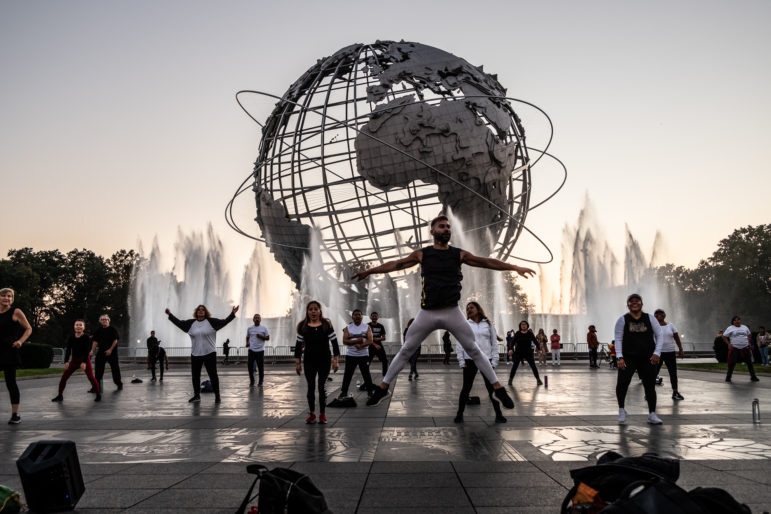City Limits is looking to speak to artists and arts groups across the five boroughs to get a better sense of the challenges they’re facing, and how government policies can help address those.

Adi Talwar
Dancers practice in front of the Unisphere in Flushing Meadows Park, QueensAre you an artist or arts group in NYC? City Limits would like to hear from you. Fill out this form to help inform our reporting on the city’s arts scene.
It’s been a tough time for New York’s arts groups and artists.
The city’s creative sector lost some 283,857 jobs during the height of the pandemic, one report found, and a July 2021 analysis by the Center for an Urban Future reported a cumulative loss of more than $1 billion in income among the art groups it surveyed since the year before the pandemic, including a quarter of arts organizations in low-income communities who reported losing their studio spaces.
While the industry continues to rebound, working artists and arts organizations have had “a very difficult past two and half years,” said Eli Dvorkin, the Center for an Urban Future’s editorial and policy director. The pandemic has been particularly hard for artists of color.
“At the same time, we’ve also seen just how important, how powerful the arts have been in renewing New York City, in bringing our economy back and giving New Yorkers a sense of pride and hope for the future,” Dvorkin said.
The future is the focus of a recent report from the policy think tank, which describes ideas for making the city a more equitable place to live. In “City of Aspiration” the Center asked 150 experts and local leaders to share a single policy suggestion, on topics such as closing education gaps and empowering young New Yorkers to get ahead, expanding opportunities for work-based learning, increasing access to good jobs by improving and expanding career training, and more.
“Who better to ask about what’s needed to help build a more equitable city than our fellow New Yorkers?” Dvorkin said, saying the goal of the “City of Aspiration” was to put “bold but achievable ideas into the hands of city officials.”
The report includes suggestions from nine stakeholders for rebuilding the city’s arts and culture sector, with a focus on inclusivity. “New York City needs to implement policies and make new investments that will drive equity,” Dvorkin said.
Schele Williams, a Broadway director and founding member of Black Theatre United, proposed the city launch a network of neighborhood-based community choirs, where people from different backgrounds “can get to know each other and learn each other’s cultures, and learn their music.”
“Perhaps music can be the key to unlocking some vital conversations,” Williams said. The choirs would offer additional opportunities for people to participate in the arts, particularly residents of color and those in low-income areas, and build a greater sense of community among participants. “Something that connects them to a neighborhood,” Williams said. “Raising your voice with other neighbors…is such an easy thing to do.”
Another example is from Alain Sylvain, founder and CEO of the consultancy group Sylvain and a member of the Mayor’s Creative Council, who proposed transforming underutilized commercial space into studios for young, diverse creatives facing unaffordable rents. This would generate “a return to creative vibrancy in struggling commercial districts,” Sylvain’s proposal explains, adding that the studios could be distributed via a lottery system.
“Not only does this turn underutilized buildings into productive places, it also creates economic opportunities for some of the city’s most disadvantaged creative talents,” his proposal reads.
Other arts-specific proposals in the report also dealt with the shortage of affordable real estate for the creative sector. David Ehrenberg, former president and CEO at the Brooklyn Navy Yard, said the city should reboot an earlier initiative called Spaceworks, a nonprofit launched during the Bloomberg administration that offered discount studio rentals to artists.
Spaceworks went out of business and shuttered its locations in the early months of the pandemic, and its closure “has left a hole,” in the sector, Ehrenberg said.
“The city should draw lessons learned from the operational challenges that the organization faced, while redoubling efforts to unlock more affordable space for the arts,” his proposal implores. “A major new effort to create clusters of affordable space for working artists—especially those from lower-income communities of color—can help counter the damage inflicted by the pandemic and address the longstanding affordability challenges facing the city’s arts sector.”
More generally, the report calls for the city to increase its investment in the creative industries by committing at least 1 percent of its annual budget to arts and culture, something advocates and some elected officials have also pushed for, citing the potential boost to jobs and tourism.
The arts provide “so many economic benefits for New York,” Dvorkin said. “We’ve seen just how important the arts have been to bringing New York City back.”
City Limits is looking to speak to artists and arts groups across the five boroughs to get a better sense of the challenges they’re facing, and how government policies can help address those.
City Limits’ series on the people, places and politics of New York City’s five-borough art scene is supported by the Laurie M. Tisch Illumination Fund.









2 thoughts on “Community Choirs, Discount Studio Space: How Should NYC Reboot the Arts Sector?”
interesting
I didn’t have any expectations concerning that title, but the more I was astonished. The author did a great job. I spent a few minutes reading and checking the facts. Everything is very clear and understandable. I like posts that fill in your knowledge gaps. This one is of the sort.